jamesp
Cave Dweller 
Member since October 2012
Posts: 36,612
|
Post by jamesp on Aug 26, 2017 7:55:13 GMT -5
Wow, glad all we have up here is stinging nettles which by comparison would be like getting tickled with a feather. The nettles in Florida produce lumps and start out with pain and move to itching. Not a plant to trifle with at all. The ones here in Georgia are about 1/10 the potency. The brilliant white flowers are your flag, they have marble sized fruit like balls on them. Maybe they are identical to yours. After research I found this Florida plant is actually not a nettle. It takes a gentle touch to trigger them. Bump them with force and many spines imbed.  "Unrelated to true nettles, this ankle-high plant with the pretty white flower is covered with stiff stinging hairs. If you brush it or touch either the flowers or leaves, the tips of the hair break off in your skin and you will be left with an intense stinging and itching sensation. After the burning and itching wears off, the encounter will often leave you with a rash, or a series of red bumps. People who are allergic have been known to suffer an even more severe reaction." This plant really attacks histamines, Benadryl slows reaction way down. Telling it is histaminic. |
|
|
|
Post by coloradocliff on Aug 26, 2017 8:13:16 GMT -5
Have you ever listened to the modern hypochondriac ? Well, this will really give them something to cry about. This vine was cut 2 years ago. Regrowth is about 60 feet up the tree. Machete kills aerial growth, not root/trunk. There is enough poison on this vine to infect everyone in a rock concert. Even after vine rots and falls to ground the rotting branches will poison you. The poison is weatherproof and long lasting, in the form of an oil. Age and repeated posionings makes most people more susceptible. It is in optimum environment here. Gives me the gee bees just looking at it. Dinosaur grass(bamboo). This is a small shade loving version to about 8 feet tall, 1/2 inch stalks. It is about all my 40 HP diesel tractor can mow. Basically it gets mowed to the ground every 4 years. Mowing mature stands kills all the young trees sprouting in it, then grows back quickly shading out the young trees before they grow back. Heavy organic mass producer, mowing makes great sheet compost. Fast soil builder, increases silica content. Bamboo full of silica. A totally low maintenance ground cover making pure stands. China and Indonesia. Tessellatus is an extremely hardy semi dwarf species that has the distinction of bearing the largest leaves of any bamboo in cultivation, up to 26 inches by 5 inches. Used extensively for erosion control. Scientific Name Indocalamus Tessellatus Light Conditions Light Sun to Shade Maximum Height 10 feet Maximum Diameter .5 inch Minimum Temperature −10 °F Larger bamboos would require 200 HP mulching machines. It can be laid over with a chain saw and bush mower can be lowered down on it slowly to chop it up as done here. Heavy job for a 40 HP tractor. God awful noises. Rots slow. Bamboo removal would probably be a lucrative service in these parts. Maybe a Bobcat front mount mulcher would handle it with a narrower cutting pass. Would require custom made equipment. Serious guards to protect operator would be required. 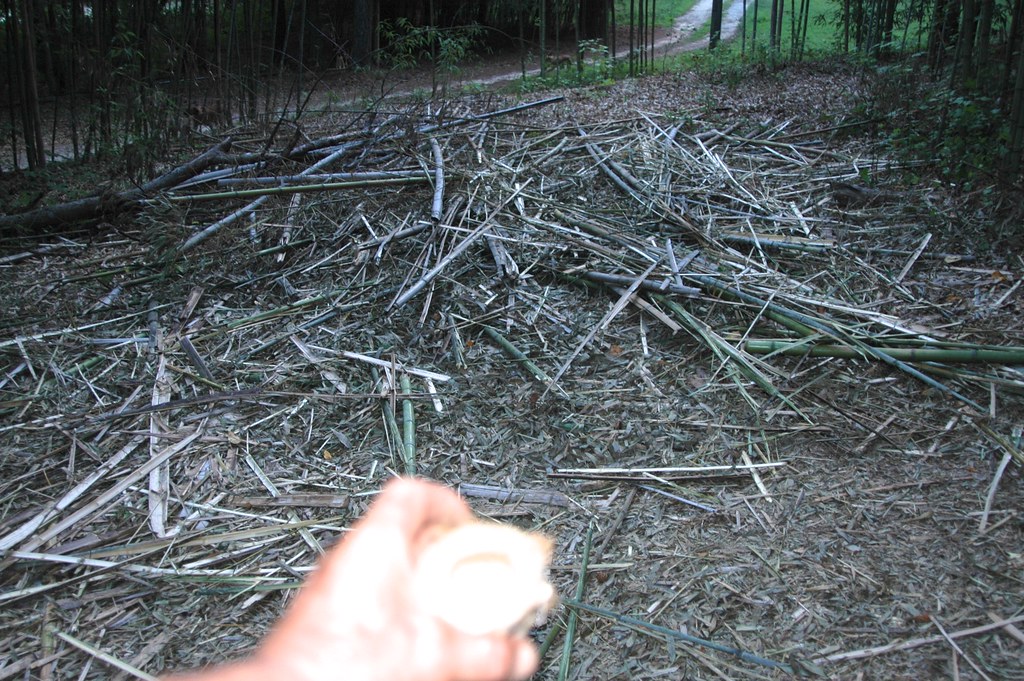 Maybe on eradication a chemical means can be found. For many years I tried and I tried to eradicate cattails from properties. Love owning properties with water on them out here in the arid west. Cattails always became an issue because apparently they liked water even more. Over the years spent many employee hours removing the things. Then a couple years back a friend who owns a flying service, search and rescue, predator control and crop dusting, was talking to me about our campers and happened to mention a surfactant he uses in aerial spraying. He gave me a small sample and had it sprayed on a nuisance patch using plain ole noneffective , previous to that point, glyphos. In 2 days the cattails were hurtin and in a week they were dead. Never would've imagined that they could be so easily killed with such a common chemical that didn't work before. The surfactant was all natural and pricy . Made from soybeans and it dissolved the waxy external leaf covering, allowing the spray to penetrate. Mayhaps if not already in use an equally effective one will be found for all the nuisance plants that take over the deep south.
|
|
|
|
Post by captbob on Aug 26, 2017 8:57:49 GMT -5
Maybe on eradication a chemical means can be found. Napalm is chemicals! sorta |
|
lookatthat
Cave Dweller  Whatever there is to be found.
Whatever there is to be found.
Member since May 2017
Posts: 1,360 
|
Post by lookatthat on Aug 26, 2017 9:04:18 GMT -5
Sumac is common around here, never seen poison oak. Sumac has no effect on me. Tree surgeons and timber men have to deal with handling trees covered in Ivy. They wear heavy clothing to help reduce exposure, winter work for sure. The Ivy is the one to avoid. 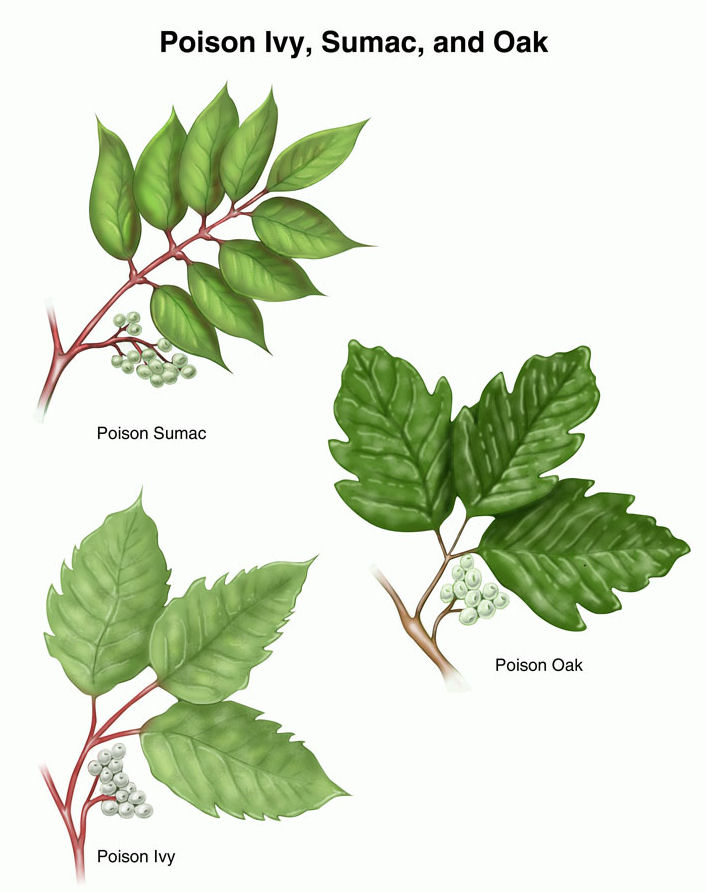 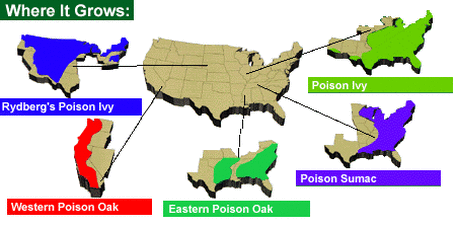 Sumac germinates in open fields, easily gets 20 feet tall. Beautiful fall colors lol. Pithy wood, mows down easily. 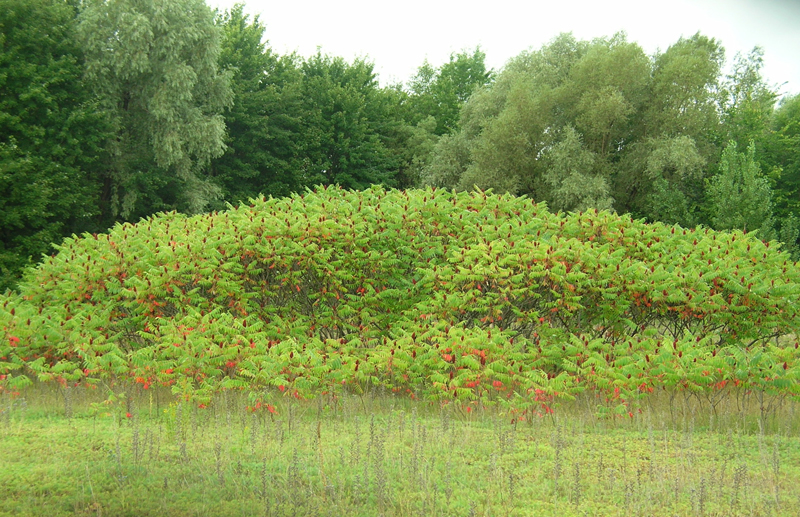 |
|
lookatthat
Cave Dweller  Whatever there is to be found.
Whatever there is to be found.
Member since May 2017
Posts: 1,360 
|
Post by lookatthat on Aug 26, 2017 9:09:45 GMT -5
To reiterate what jamesp said, the sumac in the lower picture (with the red parts) is NOT poisonous. It is staghorn sumac. A tea can be made of the red berries, and early sugarers used the hollow branches as sap spouts by removing the spongy interior.
|
|
Fossilman
Cave Dweller 
Member since January 2009
Posts: 20,723 
|
Post by Fossilman on Aug 26, 2017 9:20:21 GMT -5
We have poison ivy and poison oak.....Most people that trot the woods around here,get a bite or two with it.... The poison oak is the worst though.. Nasty stuff..(Looks like a case of the shingles)..
|
|
|
|
Post by coloradocliff on Aug 26, 2017 9:29:56 GMT -5
Maybe on eradication a chemical means can be found. Napalm is chemicals! sorta Saw it used a lot.. Very effective. Might have to get the ground really hot to cook the roots. Thermonuclear device? Also has a side benefit of reducing feral cat population.
|
|
jamesp
Cave Dweller 
Member since October 2012
Posts: 36,612
|
Post by jamesp on Aug 26, 2017 9:32:08 GMT -5
To reiterate what jamesp said, the sumac in the lower picture (with the red parts) is NOT poisonous. It is staghorn sumac. A tea can be made of the red berries, and early sugarers used the hollow branches as sap spouts by removing the spongy interior. Yep, the poison Sumac looks about the same. Except white berries instead of red. And the red is more common. Never knew there was a use for the red berried variety. Sap spouts, I get that. Tea, well, Sumac tea just does not seem appetizing. Sumac = poison in minds around these parts. curious what such a tea would provide in nutrients. |
|
jamesp
Cave Dweller 
Member since October 2012
Posts: 36,612
|
Post by jamesp on Aug 26, 2017 9:33:49 GMT -5
We have poison ivy and poison oak.....Most people that trot the woods around here,get a bite or two with it.... The poison oak is the worst though.. Nasty stuff..(Looks like a case of the shingles).. Lush Oregon vegetation HAS to be a good habitat for those plants Michael. |
|
jamesp
Cave Dweller 
Member since October 2012
Posts: 36,612
|
Post by jamesp on Aug 26, 2017 9:41:44 GMT -5
coloradocliffCattails are illegal to bring into Florida w/out permit. They take over native wetland plant populations. Glycophosphate kills cattails with no effort. Dead in short order. Right down to roots. also kills poison Ivy's and Oak's. I just use Round Up on cattails. Govt wants you to use more expensive Rodeo. Ha, they are both about 50% glyco. Equally polluting, never figured that one out. Round Up may/may not kill foliage on bamboo, usually not. It is the most difficult plant to kill with chemicals. Plus it does not travel to all the viable root nodes. It will come back. Salt will kill it, but messes up the soil. Plowing it 2-3 years after removing canes is the only way I have found to destroy bamboo. Or cut it flush to ground and put goats on it for 3-4 years. Or cover with sun block fabric. Or flood it for a year. To kill the full size standing canes- set fire to the leaves on the ground. That will kill the stalks 1st burn. Then the leaves drop, another source to burn. Lay it over with a loader, and burn again. The only problem with that is the fire leaves sharp stumps that will puncture tires. so track machines are necessary. Napalm not a bad idea. Gasoline thrown on it helps the burn, except it's just pollutive. I'm not telling about gasoline methods, I have had fires 4-5 stories tall. Add wind and you can wipe our a 40 foot tall grove in minutes. dangerous and illegal.
|
|
lookatthat
Cave Dweller  Whatever there is to be found.
Whatever there is to be found.
Member since May 2017
Posts: 1,360 
|
Post by lookatthat on Aug 26, 2017 9:46:32 GMT -5
We now have giant hogweed here. Oh joy.
Plenty of poison ivy here, but not too bad if you're careful.
But wild (poison) parsnip is my nemesis. It looks innocent and fern-like when young; when mature, it has a dill-like head that is pretty enough that unwary persons have used it in bouquets. I am terribly sensitive to it. (Not everyone is so affected.) It slow burns through my skin like an underground fire, creates wounds and scabs that take weeks to heal, and leaves scars. I've had cases so bad that I ran a fever.
|
|
lookatthat
Cave Dweller  Whatever there is to be found.
Whatever there is to be found.
Member since May 2017
Posts: 1,360 
|
Post by lookatthat on Aug 26, 2017 9:48:35 GMT -5
Regular Round-up won't kill wild parsnip; it just mutates it, quite prettily, in fact. You have to use a high concentration to actually kill it.
|
|
jamesp
Cave Dweller 
Member since October 2012
Posts: 36,612
|
Post by jamesp on Aug 26, 2017 9:59:36 GMT -5
We now have giant hogweed here. Oh joy. Plenty of poison ivy here, but not too bad if you're careful. But wild (poison) parsnip is my nemesis. It looks innocent and fern-like when young; when mature, it has a dill-like head that is pretty enough that unwary persons have used it in bouquets. I am terribly sensitive to it. (Not everyone is so affected.) It slow burns through my skin like an underground fire, creates wounds and scabs that take weeks to heal, and leaves scars. I've had cases so bad that I ran a fever. Rare here in the south. Looks like an evil plant, lots of mention of severe rashes. Does it prefer wetland environment ? |
|
|
|
Post by coloradocliff on Aug 26, 2017 10:16:14 GMT -5
coloradocliff Cattails are illegal to bring into Florida w/out permit. They take over native wetland plant populations. Glycophosphate kills cattails with no effort. Dead in short order. Right down to roots. also kills poison Ivy's and Oak's. I just use Round Up on cattails. Govt wants you to use more expensive Rodeo. Ha, they are both about 50% glyco. Equally polluting, never figured that one out. Round Up may/may not kill foliage on bamboo, usually not. It is the most difficult plant to kill with chemicals. Plus it does not travel to all the viable root nodes. It will come back. Salt will kill it, but messes up the soil. Plowing it 2-3 years after removing canes is the only way I have found to destroy bamboo. Or cut it flush to ground and put goats on it for 3-4 years. Or cover with sun block fabric. Or flood it for a year. To kill the full size standing canes- set fire to the leaves on the ground. That will kill the stalks 1st burn. Then the leaves drop, another source to burn. Lay it over with a loader, and burn again. The only problem with that is the fire leaves sharp stumps that will puncture tires. so track machines are necessary. Napalm not a bad idea. Gasoline thrown on it helps the burn, except it's just pollutive. I'm not telling about gasoline methods, I have had fires 4-5 stories tall. Add wind and you can wipe our a 40 foot tall grove in minutes. dangerous and illegal. Roundup with regular surfactantsw wouldn't touch our regular cattails without the special sticker. Florida has cattails already don't they? Never paid attention but don't blame them We have many invasive species here in Colorado. Most are real bad for the natives. Only 1 bamboo grows and over winters locally. Believe it to be yellow groove or such. Don't care for plants that don't have big flowers. grin. Lots of fire used out west for such and some get away. Controlled burns are the worst.
|
|
jamesp
Cave Dweller 
Member since October 2012
Posts: 36,612
|
Post by jamesp on Aug 26, 2017 10:52:44 GMT -5
coloradocliff Cattails are illegal to bring into Florida w/out permit. They take over native wetland plant populations. Glycophosphate kills cattails with no effort. Dead in short order. Right down to roots. also kills poison Ivy's and Oak's. I just use Round Up on cattails. Govt wants you to use more expensive Rodeo. Ha, they are both about 50% glyco. Equally polluting, never figured that one out. Round Up may/may not kill foliage on bamboo, usually not. It is the most difficult plant to kill with chemicals. Plus it does not travel to all the viable root nodes. It will come back. Salt will kill it, but messes up the soil. Plowing it 2-3 years after removing canes is the only way I have found to destroy bamboo. Or cut it flush to ground and put goats on it for 3-4 years. Or cover with sun block fabric. Or flood it for a year. To kill the full size standing canes- set fire to the leaves on the ground. That will kill the stalks 1st burn. Then the leaves drop, another source to burn. Lay it over with a loader, and burn again. The only problem with that is the fire leaves sharp stumps that will puncture tires. so track machines are necessary. Napalm not a bad idea. Gasoline thrown on it helps the burn, except it's just pollutive. I'm not telling about gasoline methods, I have had fires 4-5 stories tall. Add wind and you can wipe our a 40 foot tall grove in minutes. dangerous and illegal. Roundup with regular surfactantsw wouldn't touch our regular cattails without the special sticker. Florida has cattails already don't they? Never paid attention but don't blame them We have many invasive species here in Colorado. Most are real bad for the natives. Only 1 bamboo grows and over winters locally. Believe it to be yellow groove or such. Don't care for plants that don't have big flowers. grin. Lots of fire used out west for such and some get away. Controlled burns are the worst.
Maybe your cattails have a waxy coating or some other defense. No surprise at all. There are several species. Most common in US : cattails.info/Types_of_cattail.htmlangustifoli is easy to ID due to its slender leaves and compact habit. I had seen the cattails in your lake your photo, looked like latifolia, could be domingensi. Good luck telling them apart. 1. Typha angustifoli Narrow leaf Cattail 2. Typha domingensi Southern Cattail 3. Typha latifolia Broad leaf Cattail Yellow Groove Bamboo is seriously cold hardy. Probably the one that survives there, but that would be a challenge with those temps. I have a lot of issues with these in my bamboo, huge turds and beware. They don't like the 12 ga.. Great with lemon pepper seasoning.  |
|
|
|
Post by coloradocliff on Aug 26, 2017 11:01:16 GMT -5
Roundup with regular surfactantsw wouldn't touch our regular cattails without the special sticker. Florida has cattails already don't they? Never paid attention but don't blame them We have many invasive species here in Colorado. Most are real bad for the natives. Only 1 bamboo grows and over winters locally. Believe it to be yellow groove or such. Don't care for plants that don't have big flowers. grin. Lots of fire used out west for such and some get away. Controlled burns are the worst.
Maybe your cattails have a waxy coating or some other defense. No surprise at all. There are several species. Most common in US : cattails.info/Types_of_cattail.htmlangustifoli is easy to ID due to its slender leaves and compact habit. I had seen the cattails in your lake your photo, looked like latifolia, could be domingensi. Good luck telling them apart. 1. Typha angustifoli Narrow leaf Cattail 2. Typha domingensi Southern Cattail 3. Typha latifolia Broad leaf Cattail Yellow Groove Bamboo is seriously cold hardy. Probably the one that survives there, but that would be a challenge with those temps. I have a lot of issues with these in my bamboo, huge turds and beware. They don't like the 12 ga.  Have problems killing our cattails. Not these little birdies..The problem with these birds is getting them tender enough to eat. Would rather eat a flying lizard.. Only thing worse would be trying to choke down a Big Mac.
|
|
jamesp
Cave Dweller 
Member since October 2012
Posts: 36,612
|
Post by jamesp on Aug 26, 2017 11:03:51 GMT -5
50 caliber for these guys  |
|
jamesp
Cave Dweller 
Member since October 2012
Posts: 36,612
|
Post by jamesp on Aug 26, 2017 11:04:55 GMT -5
Big Mac's are from T-Rex.
|
|
Deleted
Deleted Member
Member since January 1970
Posts: 0
|
Post by Deleted on Aug 26, 2017 11:05:08 GMT -5
50 caliber for these guys  Spears of dragon glass might work. |
|
|
|
Post by coloradocliff on Aug 26, 2017 11:09:10 GMT -5
We now have giant hogweed here. Oh joy. Plenty of poison ivy here, but not too bad if you're careful. But wild (poison) parsnip is my nemesis. It looks innocent and fern-like when young; when mature, it has a dill-like head that is pretty enough that unwary persons have used it in bouquets. I am terribly sensitive to it. (Not everyone is so affected.) It slow burns through my skin like an underground fire, creates wounds and scabs that take weeks to heal, and leaves scars. I've had cases so bad that I ran a fever. Rare here in the south. Looks like an evil plant, lots of mention of severe rashes. Does it prefer wetland environment ? Lives at elevation in Colorado .This is about 10,000 ft. Normal to moist in early summer then dry in late summer until the cows graze it down.
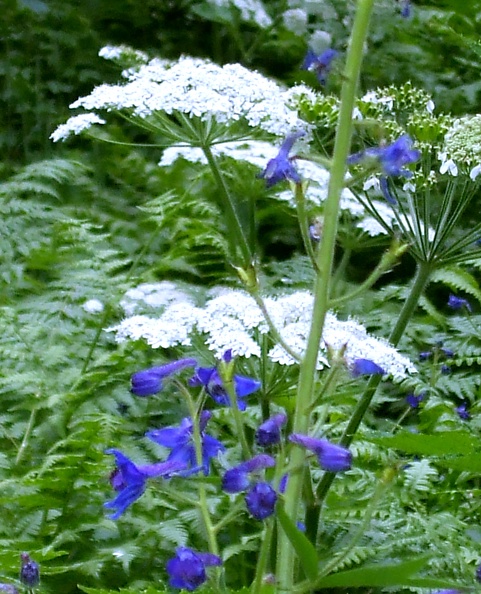
|
|